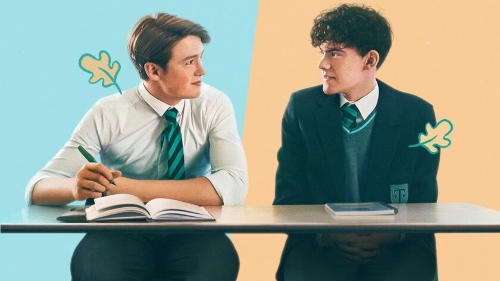
The new Netflix series Heartstopper has been a big hit for the streaming service, garnering praise for its positive depiction of LGBTQ teens.
Based on Alice Oseman‘s graphic novel, the series charts the unlikely romance between Charlie Spring (Joe Locke) and Nick Nelson (Kit Connor), classmates at an upscale British grammar school. The duo has been a favorite of Netflix subscribers since Season 1 premiered in July, and the streamer has already renewed Heartstopper for two more seasons.
Oseman adapted her own graphic novel and the series was directed by Euros Lyn, who worked on Sherlock and Black Mirror. The young ensemble cast also includes Yasmin Finney as Elle, Charlie’s transgender friend; Sebastian Croft as Ben, an abusive classmate; and Oscar winner Olivia Colman as Nick’s mother.
All eight episodes were shot by Diana Olifrova, winner of the British Society of Cinematographers Emerging Cinematographer’s Award for the short film All Of Me from director Daphne Schmon. Olifrova also shot Season of Peacock’s We Are Lady Parts and the final two episodes of HBO’s horror-comedy The Baby. She recently spoke with Below the Line over Google Meet, and the conversation was quite illuminating…
Below the Line: Heartstopper is such a warm, sensitive show. Can you talk about your overall approach?
Diana Olifrova: When I interviewed for this job, Euros, the director, kept asking me, ‘how do I show someone falling in love with a camera?’ It’s such a difficult question. A broad question. You can play around with looks when you discuss the feelings you’re trying to express. It’s instinct a little bit, the right balance of colors and lights and happy accidents. It’s impossible to describe.
BTL: Typically, romances are low contrast, soft focus, and a palette leaning toward pastels.
Olifrova: Sure, more soft focus, no contrast. I created a LUTS beforehand with my colorist, Tobias James Tomkins, to get a sort of retro look. We were shooting over seasons, so we could emphasize the different time frames in the grade because we used different white balances. In the winter I went slightly colder, in the summer much warmer in lighting and color balance, especially on the exteriors. Also, I applied filters. I had a pearlescent filter that I was using at 1.8 in the winter, and then a quarter or a half by the summer.
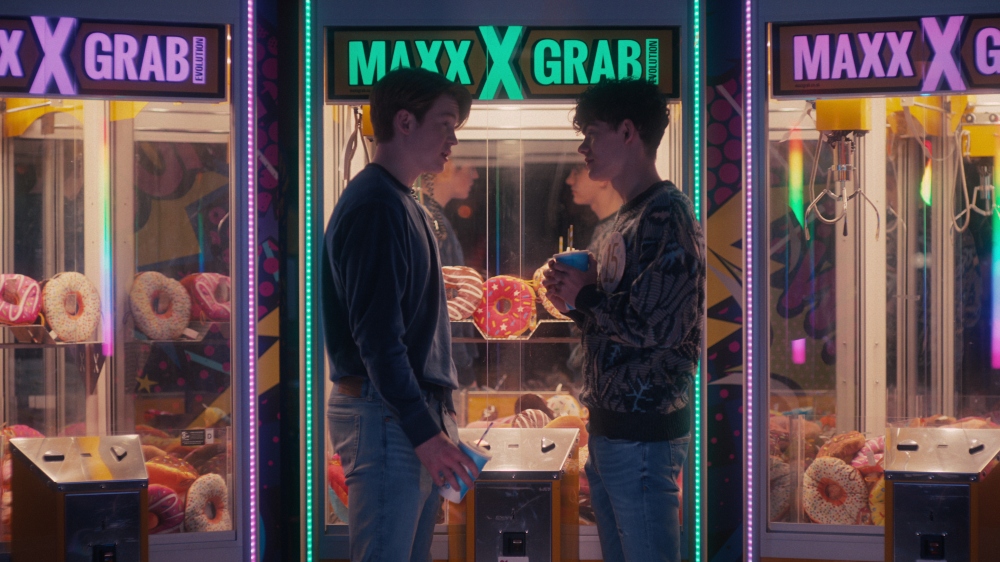
BTL: Were you using filters and gels throughout?
Olifrova: At the school. We had that location for a couple of weeks before we started, so I could do tests. We tried different gels in the school’s ceiling lighting panels. I tried yellow and slightly more green. It was quite an “old school” school, and I wanted it to be a little less appealing, a bit more uneven. Dirtier to contrast with the feelings and romance of the story, and to make the “safe space” art room that was designed by the brilliant Tim Dickel very cozy.
We shot the scene where Charlie sees Nick for the first time at the test day. They look at each other and there’s a “heartstopper” moment, then they sit down and say ‘hi.’ We did that little scene, then I went to the colorist, Toby, and we went through different looks and different ways of enhancing the image. We created a LUT that would make the image slightly more, say, turquoise in mid tones and slightly warner in highlights. Using the same color palette that Alice Oseman used in her graphic novel, turquoise, orange, pink, yellow, a mix of those colors. And in the final grade, he would just touch that up in shadows and mids.
With this LUT, you have to use more lighting overall as it was purposefully one stop darker. You “overlight” the image, but then you have a variety of things you can do to the image when you unpack it in grade. Like, make the shadows richer and more saturated.
We had a DIT, Vincenzo Onorato, on set to help monitor the HDR and apply our LUT to the rushes. He didn’t need to make many adjustments, just some scenes where the weather was changing to help level it out.
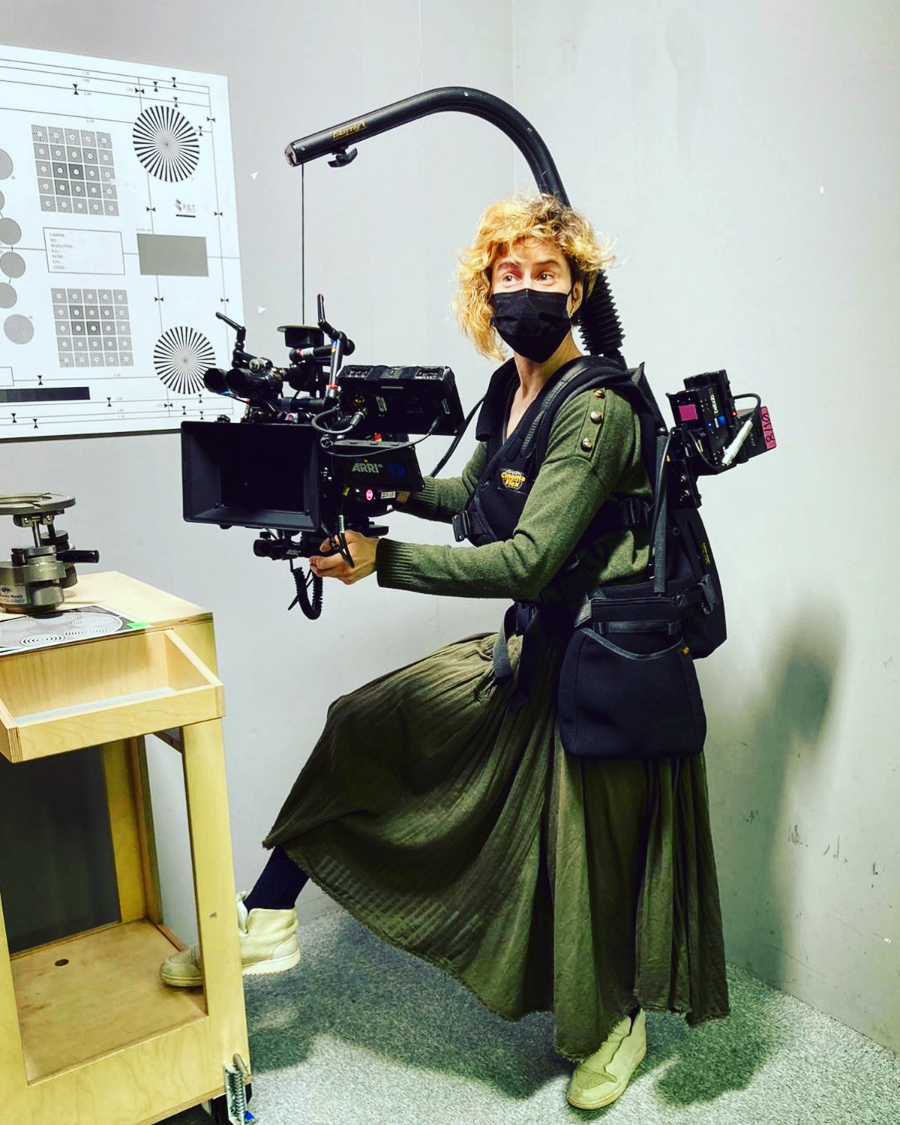
BTL: What was your camera and lighting package?
Olifrova: We used the Alexa Mini LF, a large format camera. We had Canon K35 lenses, vintage prime lenses. We used two cameras, one constantly in Steadicam mode, the other for handheld and dolly shots.
I asked my brilliant gaffer Gordon Goodwin to fill in information about the lights:
We opted for 18K Silver Bullets on Z80 machines and 20×20 Sun swats mounted on Manatou 360s in order to bring our own directional sunlight to each side of the school compound. We then employed mobile M90’S to dance about on ground level.
On the floor we used the existing florescent practicals throughout the school, all gelled with quarter plus green. We had the Art Department age the fixtures to add a certain tone and inherent ND.
HMI’s through windows were supplemented with 360 Skypannels, S60 bounce and Titan/Helios fixtures mounted/boomed in with snap grids just for shape.
Corridor scenes were lit harder and more directional to add depth, we used a series of smaller HMI’s, M18/M8’s in conjunction with the 18ks and created ambient by rigging Titans/Helios tubes into our blacked out light wells matching practical color through metering and inputting X&Y coordinates.
Locations and sets were predominantly lit with Tungsten, Molebeams, China balls, pracs and bounced sources gave us the look we wanted.
Exteriors were lit with 18k’s in combination with machine mounted neg/diff/bounce as required.
Other locations involved everything from a 4×4 muslin poly to weeks of rigging.
BTL: Diana, are you operating?
Olifrova: I operated the A camera, and the B camera was James Burgess, the Steadicam operator. It was a luxury to have the Steadicam whenever we wanted to do something complicated.
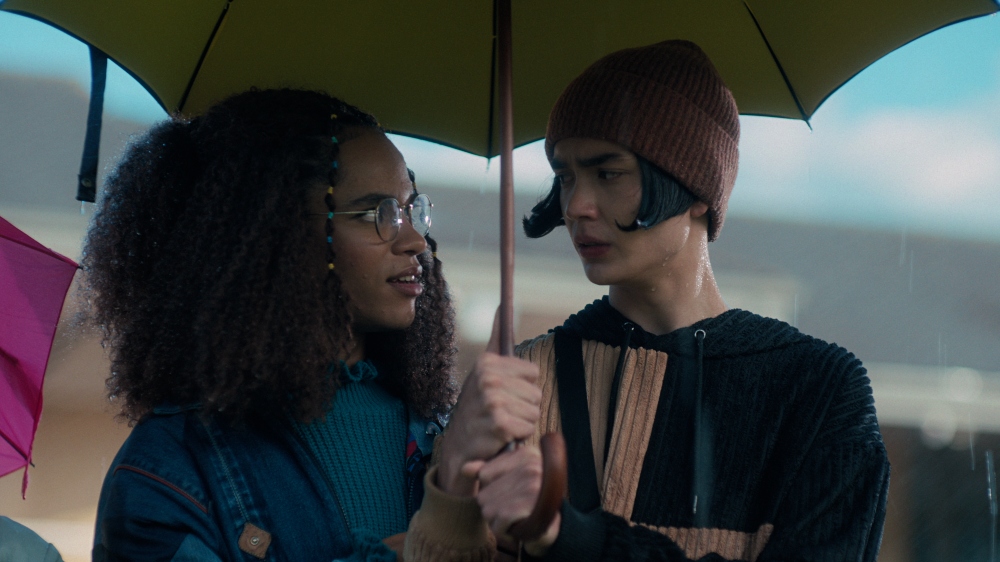
BTL: What was your schedule like?
Olifrova: We had about 50 days, two-and-a-half months. This was early 2021, so still a strict COVID situation in Britain.
I think we had two or three weeks scheduled at the school, because we wanted to go through seasons. We would shoot a week in school, go away, come back when it’s a little bit warmer, go away again. The unit was there the whole time, plus we built sets there, for example, the bedroom interiors for Charlie and Nick, and Elle. We always tried to shoot in order if possible.
BTL: Were the COVID protocols a problem?
Olifrova: They were hard, especially because the interiors were quite small and hot. We discussed everything and made it work for our shoot.
BTL: You also had a lot of potentially tough romantic scenes.
Olifrova: A lot of kissing and then some fighting too. David Thackeray, our Intimacy Coordinator, was really good. I wasn’t that involved, it was mainly David and Euros, but I was always aware when he would suggest good ways to cover scenes.
Actors are very sensitive, and you are kind of fragile together with them — just being very attuned to what’s happening and how they feel. Having this handheld camera, being in the moment, moving with them, trying to help them convey this emotion of falling in love or just being excited about something. It was quite spontaneous in a way, very magical when it worked.
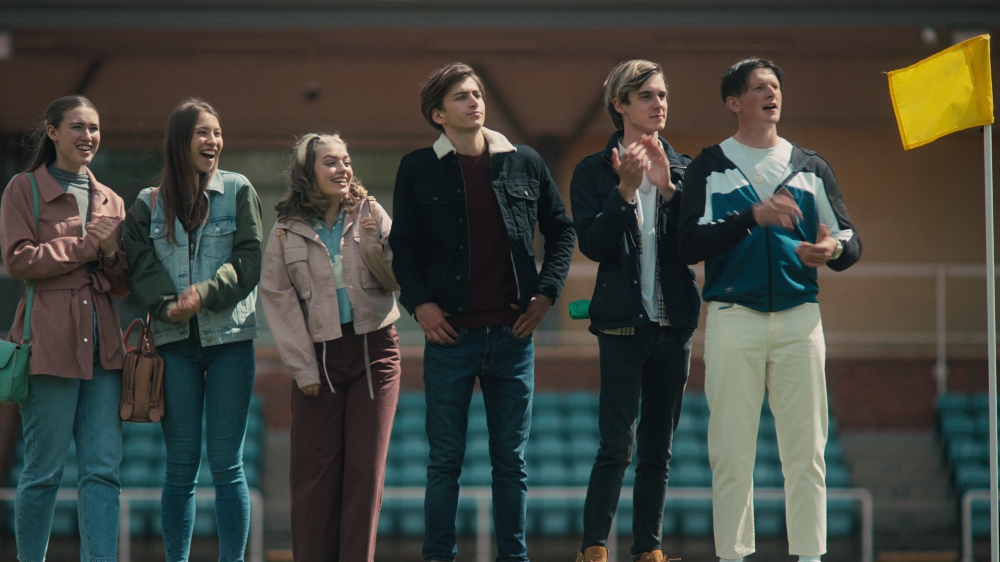
BTL: You are so close to the performers in those scenes, they must have trusted you.
Olifrova: There’s a lot of trust both ways, all of us together. I trusted them and they trusted me. It was very open. Everybody could do what they wanted to.
I really felt every embrace. I kind of danced with them on my knees on the Easy Rig (which was very well balanced and customized to have a battery on the back by my amazing 1st AC Ran Geffen). It was hard physically but so exciting at the same time.
I was like, ‘Let’s just go for it.’ I don’t think Ran, the focus puller, was very happy. We weren’t doing a lot of measuring or rehearsing. But since the actors were quite young, some of them working for the first time, I felt it was important for them not to get too wrapped up in hitting marks and all that. You know, ‘Move this way, stay there, do that.’ Being a bit free really helps them. Running the scenes and the takes longer helps them. So yeah, for the focus puller with a large-format camera and a tiny depth of field, it was not easy. I admire their skills and bravery to go for it with me.
BTL: Plus, you can’t ask these kids to do heavy emotional scenes over and over. Did using two cameras help in those moments?
Olifrova: No, those are very small spaces. We couldn’t use two cameras, especially in the interiors. It’s handheld, so it’s quite easy to reset things. You don’t need to bring a dolly back to the start point.
Also, I keep pushing for thinking “with one eye” rather than spreading yourself too thin. I find it harder with two cameras to be more of an author of the image. I’d rather cover the emotional scene with one camera, and use the other one to “leapfrog” — prepare for the next set-up or scene.
It’s much easier to light and be more emotional with one camera. But you can be smart [by] utilizing two cameras to make the process more time-efficient.
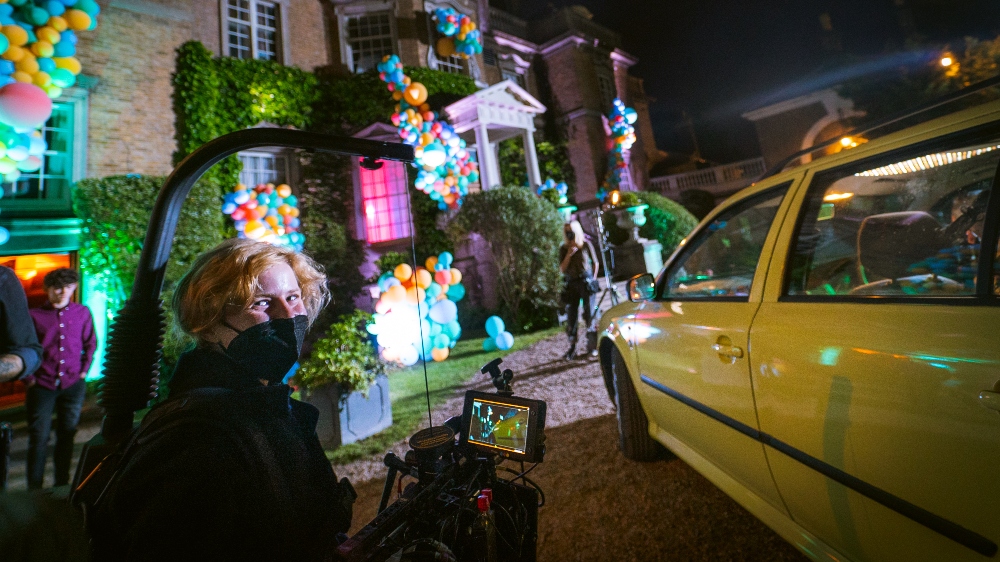
BTL: Did you know what music would be on the soundtrack?
Olifrova: Sometimes. My favorite scene is the kissing scene between Tara (Corinna Brown) and Darcy (Kizzy Edgell) during that big party. I think music can be very powerful when everybody needs to be on the same energy level. This song goes, “Tell me, tell me you’ll meet me … Will you meet me more than halfway up?” and it was on when we were filming. It really helped me sync with them, it was like a cue for me to move in. It was amazing. I remember hoping it would end up in the cut. I was crying when I shot it, and I cry now watching it because it’s a big blast of positivity and happiness.
BTL: Did you know when animation would be used?
Olifrova: Yes, those were called “Heartstopper” moments, they were all written into the script. We experimented trying to do some of them in camera. Sometimes they worked, like when Elle’s glasses reflect stars. We made them the old-school way, using star-shaped bulbs attached to a piece of Black Bolton, dimmed up and down.
Some didn’t work. We tried to create actual sparkles for one shot where the two hands touch, but it became too complicated and time-consuming. Instead, we went for a simple light dimming up effect and the rest was animation applied on top of the image.
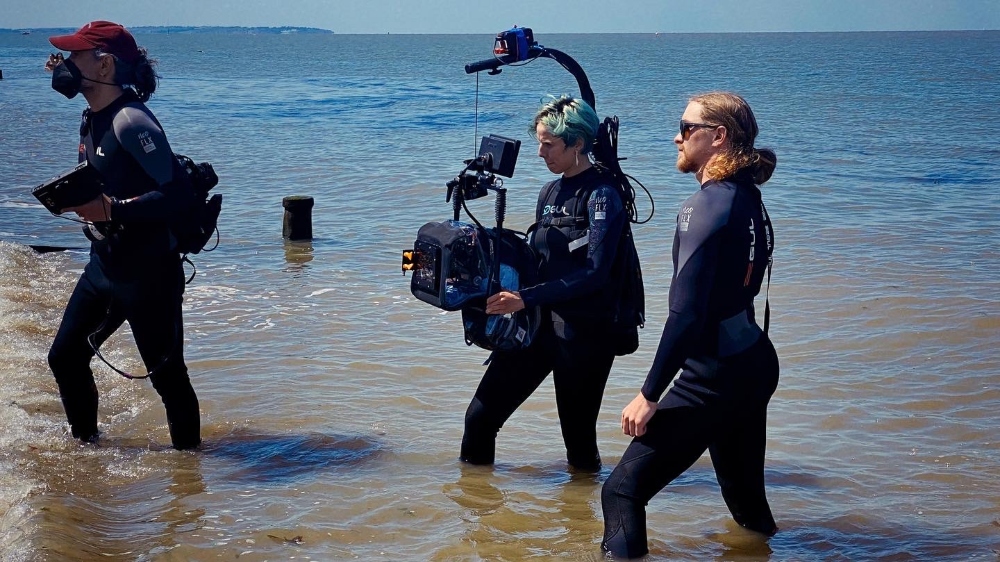
BTL: You frequently use split screens. Did that come from the original comics?
Olifrova: Actually we used a lot of Alice’s frames as inspiration for the storyboards. In a way, they were our storyboards. Sometimes when we were shooting Euros would look at a page and say, ‘Look, Alice put this guy at the edge of the image, so it looks really lonely. Can we do something like that?’ So our work became a real homage to the book. Now fans are comparing book screenshots and frame screenshots.
Alice really played with frames in the comic book, she had a lot of creative freedom that sometimes you don’t have in film. Like, she will bridge two frames with a little leaf between them to tie the emotions together. But you can’t use a leaf like that in film. How can we make that feeling of loneliness work? How can we show that feeling of how you’re thinking about someone?
Of course, that’s the edit, the pacing, the length of the shot, how the camera moves. Without being able to use her devices, you’re always thinking of cinematic solutions to find what’s important to end this scene on. Because her choices were so powerful, her work is so poetic. It was important to keep that poetry in there. Her little metaphors inside frames.
BTL: When you’re a teenager, every moment is so heightened. Everything that happens is the most important thing in the world. You capture that gravity so well.
Olifrova: I hope so. I’m very empathetic. I really believe, the same way the characters do. When I see them act, I’m right there. I’m angry with them, happy with them, upset with them. I lean into their feelings and try to breathe with them. Especially with handheld cameras, see into their eyes, [and] feel constantly present and switched on.
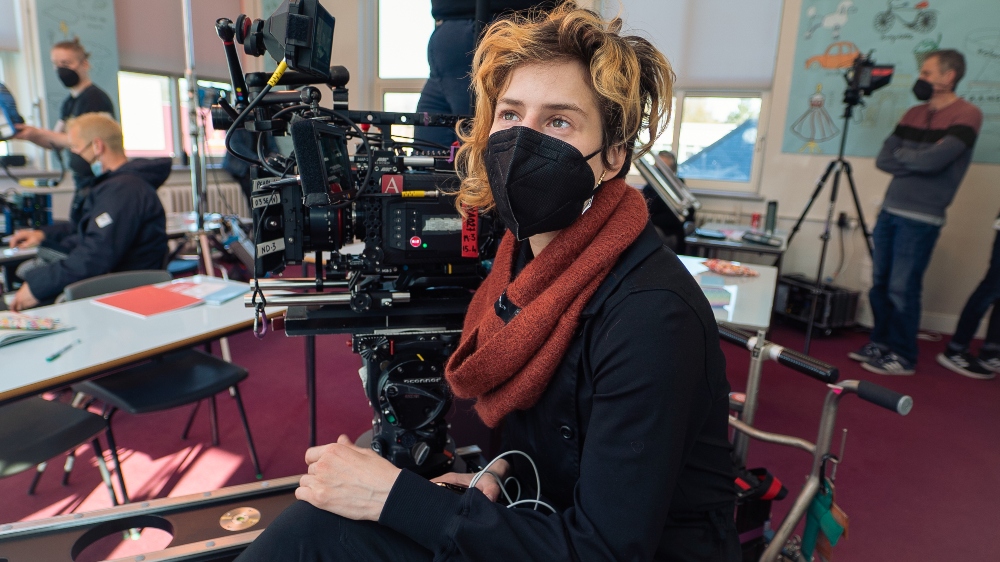
BTL: Can you talk about your other projects?
Olifrova: I did Episodes 7 and 8 of The Baby on HBO. It’s by Lucy Gaymer and Siân Robins-Grace. Kate Reid shot the first three episodes, then Ben Wheeler did 4, 5, and 6. The episodes are very different, [and] the style changes throughout the show. It’s quite interesting stylistically and I really enjoyed that.
BTL: How would you describe the style of your episodes?
Olifrova: The show is a horror-comedy, something quite new to me. It was a big challenge working with babies. I liked how I could really lean into a cinematic style, [and] emphasize lighting and colors to make it very dark, strange, and original.
BTL: Finally, what’s your reaction to how viewers have taken to Heartstopper?
Olifrova: The response has been overwhelming. It’s so nice to hear that people feel like they are “being seen.” That applies to the production itself — our crew is very diverse and this only makes our collaboration stronger and more exciting.
The real genius is Alice Oseman and her beautiful comic book. We were able to make an authentic and honest series that speaks to a very broad audience and that provokes conversation. That’s one of my personal aims — to make work that I believe in and that is important for the world to see, feel, and understand.





